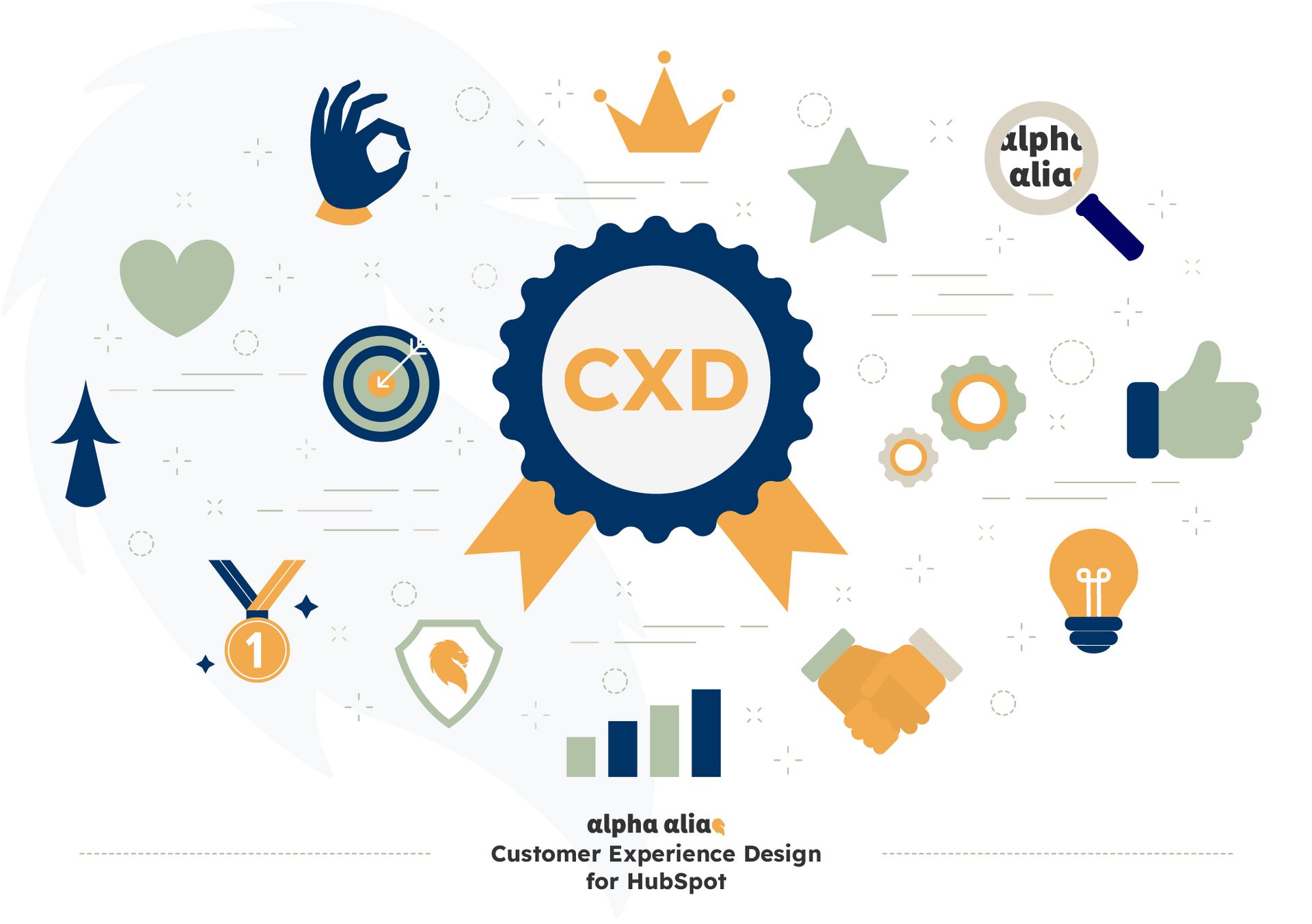Tagline

Introduction to Customer Experience Design for Business Growth
Crafting an unforgettable customer experience (CX) isn't just about understanding your customers but continuously improving and adapting your strategies to keep them engaged and satisfied.
Part two of our exploration into Customer Experience Design dives into the practical steps businesses can take to build a successful CX strategy and the advanced techniques and tools to enhance the customer experience.
Customer Experience Design for HubSpot (Part 2)
This article is the second in a two-part series on Customer Experience Design for HubSpot. In part one, I covered the basics of customer experience design and its impact on customer satisfaction and loyalty.
In part two, I dig into the process of building and enhancing Customer Experience Design for Business Growth.
The two-part series on Customer Experience Design for HubSpot is a valuable resource for businesses facing customer experience challenges. It aims to educate and encourage, providing practical steps and advanced techniques for an impactful customer experience transformation.

A Comprehensive Guide to Building a CX Strategy: The Steps to Achieve Greater Customer Satisfaction & Loyalty
The journey to crafting a stellar customer experience starts with comprehensive customer research. The research process involves digging into the data, understanding customer behaviours, and gathering feedback through various channels, including surveys, social media, and direct interactions.
The resulting insights help create detailed customer personas, giving businesses a clearer picture of who they're serving and what their customers value.
Creating new touchpoints and modifying existing assets based on these personas ensures businesses meet and exceed customer expectations at every interaction.
Addressing pain points effectively and setting clear, measurable goals are also pivotal. This approach allows businesses to focus on meaningful improvements that resonate with customers, enhancing satisfaction and loyalty.
A guided approach to Customer Experience Design
In this section, I provide a comprehensive overview of how to gather data, make data-driven decisions, and implement an effective customer experience strategy.
The steps below are written in a way that suits any business or industry, including B2B and B2C.
If anything I've written is difficult to understand, or if you're interested in a full-service customer experience transformation from an official HubSpot Partner, feel free to reach out and I'll help in any way I can.

Step 1: Conduct comprehensive customer research
Start by delving into the data, understanding customer behaviours, and gathering feedback through various channels, including surveys, social media, and direct interactions.
This research helps create detailed customer personas, giving businesses a clearer picture of who they're serving and what their customers truly value.
Practical steps to conduct comprehensive customer research
- Define your research objectives: Before starting your research, it is important to define what you want to achieve and what questions you want to answer. This will help guide your research and ensure you collect relevant data.
- Identify your target audience: Decide who to survey or interview. Your target audience should reflect your customer base or the audience you want to reach.
- Choose your research methods: There are many ways to gather data, including surveys, focus groups, interviews, and social media listening. Choose the most appropriate methods for your research objectives and target audience.
- Create your survey or interview questions: Develop a set of questions that will help you gather the information you need. Be sure to avoid leading questions and keep them concise and clear.
- Conduct research: Administer your survey, conduct interviews or focus groups, or monitor social media to collect data.
- Analyse your data: Identify patterns and trends once you have collected it. Use this information to create customer personas.
- Create your customer personas: Based on your research findings, develop detailed profiles of your customers. Include information such as age, gender, interests, and behaviour patterns.
- Use your personas to inform your business strategy: Use your customer personas to guide your marketing, product development, and customer service strategies.

Step 2: Define your CX vision
Determine your desired end-state, your customer experience, and how it fits within your overall business strategy. Define your desired end-state for customer experience.
This step involves determining what you want your customer experience to look like. Consider factors such as ease of use, personalisation, and convenience.
How to define your Customer Experience vision
- Align your customer experience vision with your overall business strategy. Your customer experience vision should be consistent with your overall business strategy. It should support your organisation's mission, values, and goals.
- Develop a plan to achieve your CX vision. Once you clearly understand what you want your customer experience to look like and how it fits within your overall business strategy, you can develop a plan to achieve your CX vision. This may involve changes to products, services, processes, technology, or organisational structure.
- Monitor and measure progress toward your CX vision. It's important to monitor and measure progress regularly. This will help you identify areas for improvement and adjust your plan as needed.
- Continuously improve your CX. Customer experience is an ongoing process, and continuously enhancing your CX over time is essential. Regularly gather customer feedback and use it to make informed decisions about improving your CX.

Step 3: Map the customer journey
Develop a comprehensive understanding of the customer journey, including their interactions with your business across all touchpoints, to identify critical opportunities for improvement and develop a plan for enhancing the overall experience.
How to map the customer journey
- Define the customer journey stages: Start by identifying the various stages. This could include awareness, consideration, purchase, and post-purchase.
- Gather customer feedback: Collect feedback from customers at each stage of the journey to understand their experience, pain points, and areas for improvement. This could be done through surveys, interviews, or focus groups.
- Analyse customer data: Use data from customer interactions across all touchpoints to identify patterns and trends in customer behaviour. This could include website analytics, sales data, and customer service logs.
- Map the customer journey: Create a visual map, including all touchpoints and interactions. This will help you identify gaps and opportunities for improvement.
- Identify opportunities for improvement: Based on your analysis, identify critical areas where you can improve the customer experience. This could include optimising your website, streamlining your checkout process, or improving customer service.
- Develop a plan: Develop a detailed plan for enhancing the customer experience, including specific actions, timelines, and responsibilities.
- Implement and monitor: Implement your plan and monitor the results. Continuously gather customer feedback and adjust your strategy to ensure ongoing improvement.

Step 4: Define CX metrics and goals
Establish clear, measurable goals that align with your business objectives and customer expectations. Define key performance indicators (KPIs) that will be used to track progress and measure success.
How to define customer experience metrics and goals
- Identify and prioritise your business objectives: Start by identifying the business objectives that are most important to your organisation. These objectives should align with your overall business strategy and be specific, measurable, achievable, relevant, and time-bound (SMART).
- Define your customer expectations: Next, you need to define your customer expectations. This can be done through customer surveys, focus groups, or by analysing customer feedback. Customer expectations should be specific, measurable, and aligned with your business objectives.
- Define your CX metrics and goals: Based on your business objectives and customer expectations, you need to define your CX metrics and goals. These metrics should be specific, measurable, and relevant to your business. Some standard CX metrics include Net Promoter Score (NPS), Customer Satisfaction Score (CSAT), and Customer Effort Score (CES).
- Establish KPIs: Once you have defined your CX metrics and goals, you need to establish KPIs. KPIs are specific metrics that you will use to track progress and measure success. They should be aligned with your CX metrics and goals and easily measurable.
- Implement a CX measurement program: Now that you have defined your CX metrics and goals and established KPIs, you need to implement a CX measurement program. This program should include regular surveys, feedback collection, and data analysis to track progress and adjust as needed.
- Share results and take action: Finally, you need to share your results with stakeholders and take action based on the data. This may involve changing your product or service, improving customer service, or implementing new processes to improve the customer experience.

Step 5: Develop a CX roadmap
Create a roadmap that outlines the specific initiatives and actions required to achieve your CX vision and goals. Prioritise initiatives based on impact and feasibility.
How to develop a customer experience roadmap
- Define your CX vision: Define what your customers want to feel and experience when interacting with your brand. This will help guide your roadmap and ensure all initiatives align with your CX goals.
- Conduct a CX assessment: Evaluate your current CX capabilities and identify areas for improvement. This can include gathering customer feedback, analysing customer data, conducting internal reviews, and benchmarking against competitors.
- Set CX goals: Based on your CX assessment, set specific and measurable goals that align with your CX vision. These goals should be focused on improving customer satisfaction, loyalty, and advocacy.
- Prioritise initiatives: Using impact and feasibility criteria, prioritise the initiatives that will most impact your CX goals. This can include initiatives related to customer service, product development, marketing, and more.
- Create a roadmap: Once you have identified your initiatives, create a detailed roadmap that outlines the specific actions required to achieve each initiative. This roadmap should include timelines, budgets, and responsible parties for each initiative.
- Monitor and adjust: As you implement your roadmap, monitor progress and adjust as needed. This may involve revising timelines, reallocating resources, or shifting priorities based on new information or feedback.

Step 6: Engage and empower employees
Engage and empower employees to deliver exceptional customer experiences. Provide the necessary training, tools, and resources to ensure employees can consistently deliver on your CX vision.
How to engage and empower your employees for optimal customer experience
- Define your CX vision: Clearly define your CX vision and communicate it to your employees.
- Identify key CX behaviours: Identify the key behaviours employees need to exhibit to deliver exceptional customer experiences.
- Develop a training program: Develop a comprehensive training program that teaches employees the necessary skills and behaviours needed to deliver on your CX vision.
- Provide ongoing coaching: Provide ongoing coaching to reinforce the training and ensure that employees are consistently delivering on your CX vision.
- Invest in technology: Invest in the right technology to enable employees to deliver exceptional customer experiences. This could include tools for tracking customer interactions, analysing customer feedback, and providing personalised recommendations.
- Recognise and reward success: Recognise and reward employees who consistently deliver exceptional customer experiences. This will help reinforce CX's importance and motivate employees to continue providing outstanding results.

Step 7: Continuously measure and improve
Regularly measure progress against your CX metrics and goals, and use the insights gained to identify areas for improvement and refine your CX strategy.
How to measure and improve customer experience metrics
- Identify your CX metrics and goals: Clearly define the key performance indicators (KPIs) that you will use to measure customer experiences, such as customer satisfaction scores, net promoter scores, or customer effort scores. Set specific goals for each KPI.
- Collect customer feedback: Gather customer feedback through surveys, feedback forms, social media, and other channels. Use the feedback to understand customer needs, pain points, and opportunities for improvement.
- Analyse the feedback: Analyse the feedback data to identify trends, patterns, and areas where customers have issues. Use this information to prioritise areas for improvement.
- Share feedback with stakeholders: Share the feedback data and insights with relevant stakeholders, such as product managers, customer service teams, and executives. This will help everyone understand the customer experience and the opportunities for improvement.

Step 8: Develop an action plan
Based on the feedback data and insights, develop an action plan to address the areas for improvement. Set specific goals, assign responsibilities, and establish timelines.
How to develop a customer experience action plan
- Implement the action plan: Execute the action plan and monitor progress against the goals. Make adjustments as needed.
- Evaluate the results: Regularly measure progress against your CX metrics and goals, and use the insights gained to identify areas for improvement and refine your CX strategy.

Customer experience guide conclusion
Following the practical steps outlined above, you can conduct comprehensive customer research, define your CX vision, map the customer journey, and establish clear CX metrics and goals.
These steps will help you create a customer-centric strategy that improves the overall experience and drives business success.
As you continue to enhance your CX, advanced techniques and tools can help you take your strategy to the next level. In the next section, we'll explore some of these techniques and tools in more detail.
Advanced Techniques and Tools in CX Design
In today's competitive business landscape, providing top-notch customer experience is essential for any business to stand out. HubSpot's advanced tools and Alpha Alias' techniques can help companies to achieve this goal.
Alpha Alias, a
HubSpot Partner agency, utilises techniques with our clients to create engaging customer experiences and drive conversions that boost customer loyalty.
Practical examples of CX Design techniques
- Persona Development: Creating detailed customer personas to help businesses understand their customers better and design experiences that meet their unique needs and preferences.
- Journey Mapping: Mapping out the customer journey to help businesses identify pain points and opportunities for improvement in the customer experience.
- A/B Testing: Testing different versions of customer experiences to help businesses identify what works and what doesn't, ultimately leading to better customer experiences.
- Voice of Customer Analysis: Analysing customer feedback to help businesses gain insights into customer preferences and expectations, enabling them to design experiences that meet those needs.
Alpha Alias services that include CX Design
HubSpot's Customer Experience Design tools
HubSpot offers a suite of advanced tools that help businesses create, manage, and optimise customer experiences.
- HubSpot CRM: A powerful tool for managing customer interactions and tracking behaviour.
- HubSpot Sales Hub: A tool that enables sales teams to track and manage customer interactions, automate tasks, and close deals faster.
- HubSpot Marketing Hub: A suite of tools for creating and managing marketing campaigns, including email marketing, social media management, and SEO optimisation.
- HubSpot Service Hub: This is a platform for providing proactive customer service and support, including a knowledge base, live chat, and ticketing system.
Do you have questions about HubSpot?
Alpha Alias is a full-stack HubSpot Partner.
Let's discuss your customer experience transformation and the world's leading CX tool: HubSpot.
Conclusion: The Continuous Journey of CX Design
Customer Experience Design is an ongoing process that requires continuous evaluation and adaptation.
Businesses can create a CX that genuinely stands out by prioritising customer needs, collecting and analysing feedback, and constantly seeking improvement. This leads to customer loyalty and satisfaction, which drives growth by attracting and retaining new customers.
Looking to elevate your customer experience? Explore how our Customer Experience Design services can transform your business and create positive and memorable interactions with every customer.
Remember, in business, the customer's journey is never static. It evolves with every new technology, trend, and customer preference.
Staying ahead in CX Design means being flexible, innovative, and customer-focused.
By implementing the strategies and utilising the tools discussed in this article, businesses can provide an experience that keeps customers returning for more.
FAQ
What is CX design, and how can it help my business grow?
Ask Alpha Alias how CX Design can help your businessCX design, or Customer Experience Design, is the process of designing and improving the experience your customers have with your brand.
It can help your business grow by improving customer satisfaction and loyalty, which leads to increased sales, repeat business, and positive word-of-mouth referrals.
How can I create a successful CX strategy?
Ask Alpha Alias how CX Design can help your businessA successful CX strategy requires comprehensive customer research, a clear understanding of your customer personas, and a focus on meaningful improvements that resonate with your customers.
Setting clear, measurable goals and monitoring progress towards achieving them is essential.
What advanced techniques and tools can I use to enhance the customer experience?
Ask Alpha Alias how CX Design can help your businessMany advanced techniques and tools are available to enhance the customer experience, including personalisation, omnichannel marketing, chatbots, and customer journey mapping.
It's essential to choose the techniques and tools that are most appropriate for your business and align with your CX strategy.
How can I measure the success of my CX strategy?
Ask Alpha Alias how CX Design can help your businessMeasuring the success of your CX strategy involves:
- Tracking and analysing customer feedback.
- Monitoring metrics such as customer satisfaction and Net Promoter Score (NPS).
- Analysing customer behaviour and engagement.
It's essential to regularly review and adjust your CX strategy based on these metrics.
How can I get started with CX design?
Ask Alpha Alias how CX Design can help your businessGetting started with CX design involves:
- Conducting comprehensive customer research.
- Defining your CX vision and goals.
- Developing a plan to achieve them.
Creating customer personas and aligning your CX strategy with your overall business strategy is also important.
If you are unsure where to start, Alpha Alias can guide you.



